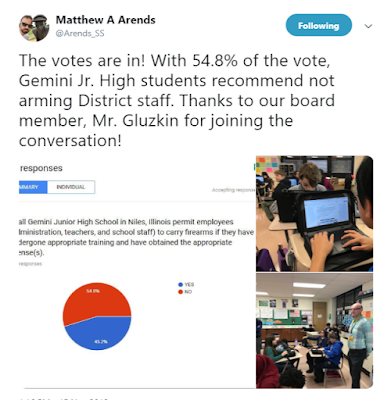A Veteran Civics Teacher’s Case for #CivicsInTheMiddle
by Mary Ellen Daneels, Lead Teacher Mentor
The Election of 2018 has often been called a “Sputnik” moment for civic education. No matter where you fall on the political spectrum, both sides of the aisle have been increasingly alarmed by the effects of political polarization on our republic. One of the unintended consequences of educational initiatives related to STEM and No Child Left Behind is that social studies has been increasingly marginalized in grades K-8. By passing HB 2265 on Tuesday, the Illinois Senate Education Committee took a positive step towards returning to the civic mission of schools and putting “civics in the middle” through legislation requiring a least a semester of civics within grades 6, 7, and 8.
While the Illinois civics standards and school code requirements clearly describe knowledge needed to prepare students for civic engagement (content) — HB 2265 is needed to further define the skills and dispositions educators need to build in students through the use of direct instruction on government institutions, current and societal issue discussions, simulations of democratic processes, and service learning (proven pedagogical practices).
Why are these proven practices so powerful? When we engage students in:
- Direct instruction of government institutions, young people learn about our federal system of government. They learn how local, state and federal governments divide power for efficiency and efficacy. Young people understand that they are important members of society with rights and responsibilities that they can exercise NOW to make their community a better place.
- Simulations of democratic process, young people learn how government institutions work and how to navigate networks related to voting, jury service, the legislative process, criminal justice, and other complex systems. Students build an appreciation for the service of elected officials and participatory citizenship.
- Current and societal issue discussions, students build important literacy skills related to reading, writing, speaking and listening. Students learn how to curate complex information and build media literacy capacities. Dispositions related to critical thinking, communication, creativity, collaboration, and compassion for others are employed and used as they work together to understand and address issues related to equity, identity, justice, power, and liberty.
- Service learning, we are not waiting for students to turn 18 to practice citizenship — we provide an opportunity for them to take real world action in a safe environment NOW through investigation, planning, preparation, action, reflection, and demonstration of learning.
What might this look like in classroom practice? Consider Matthew Arends from Gemini Junior High in Niles. This past fall, his class engaged in an examination of the current and societal issue of school safety after preparation by Matthew through direct instruction. After engaging in a Structured Academic Controversy on arming teachers, students used a simulation of democratic processes to deliberate the issue. To communicate their conclusions, students took informed action through service learning, polling their peers and other stakeholders. Students shared the results with a school board member to inform his vote on a pending resolution regarding arming teachers.
Matthew’s students provide a snapshot of the work many middle schools have embarked on with the new Illinois Social Science Standards through inquiry leading to informed action. HB 2265 will ensure that ALL students in the state have equitable opportunities to build and use civic knowledge no matter their race, socioeconomic status, or geographic location.
In the past few years, the #CivicsIsBack team has worked with over 2000 middle school teachers throughout the state of Illinois. We have found that with no state mandated social science coursework requirements, some schools choose to “cover social studies” in double periods of Language Arts classes through the periodic use of historical texts taught as pieces of literature, but not necessarily in their historical context. In other schools, there is no explicit instruction of civics beyond a week of preparation for a multiple choice exam on the U.S. and Illinois Constitution. These realities are not an indictment, rather the consequence of social studies being squeezed out as a result of other initiatives. This is a disservice to the youngest citizens to our communities. ALL students deserve access to the knowledge and skills needed to navigate our political institutions and an opportunity to explore their rights and responsibilities in this republic.
The McCormick Foundation is taking the lead and using the successes of the high school course implementation to support middle school teachers, schools, and districts to incorporate civics in 6th, 7th, or 8th grade. This will be done through a three-year, privately funded plan in which $1 million dollars with be invested annually to support professional development and the development of resources for #CivicsInTheMiddle.
How can you support the equitable preparation of ALL Illinois students for civic engagement?
- Contact your state senator and urge him or her to vote “yes” for HB 2265.
- If you are a middle school educator, please take this online survey to assess needs for implementation.
- If you are a high school educator, please take this online survey to assess the implementation of high school civics — this information will further guide our work in this space and in middle school.
- Subscribe to our #CivicsIsBack newsletter to get connected to resources and updates on policy related to civics in the classroom.





Comments
Post a Comment